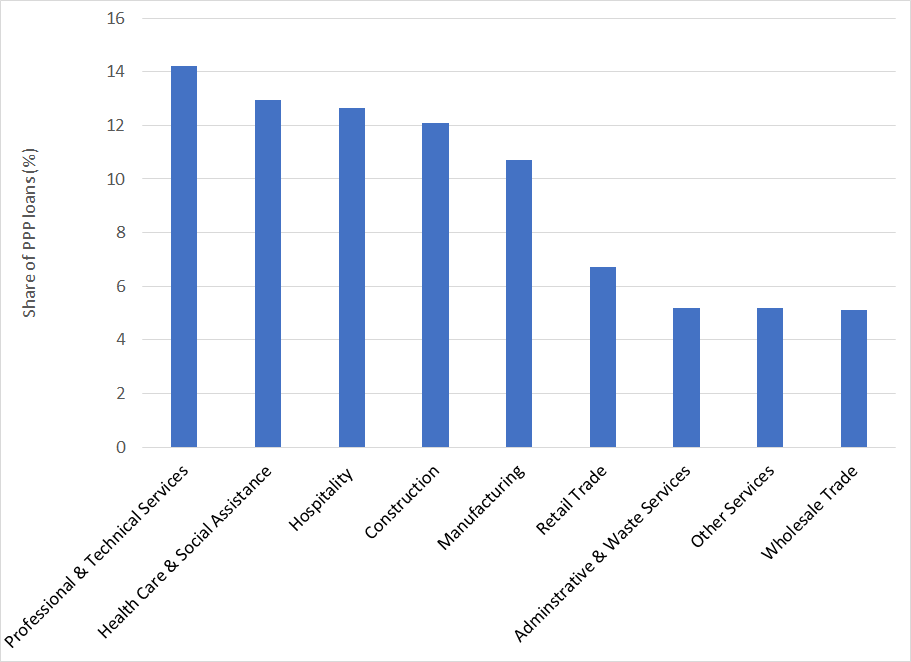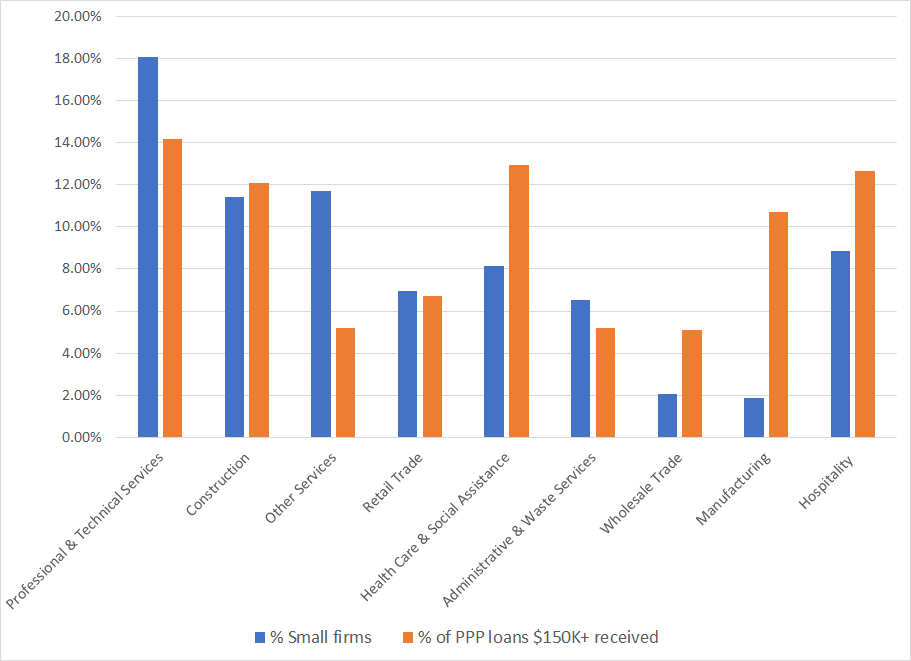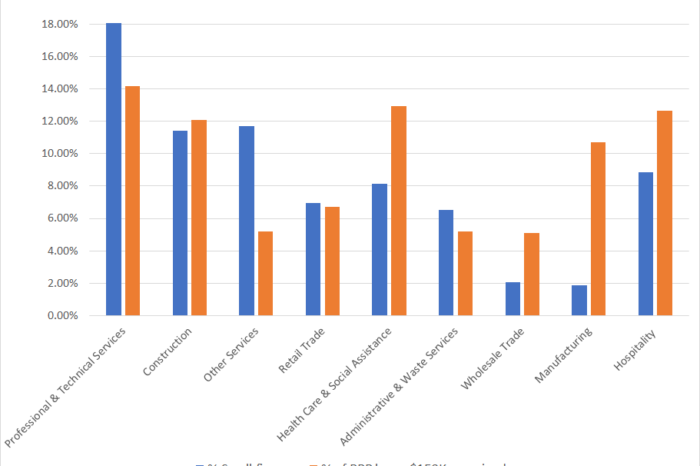Where Did the Largest PPP Loans Go? Assessing the distribution of loans by industry
The coronavirus has wreaked havoc on all parts of the economy, including small businesses. As part of the $2.2 Trillion CARES Act, Congress created the Paycheck Protection Program (PPP) with the explicit intent of helping small businesses survive the tumult of the past few months. The PPP provides low-interest — and, in many cases, forgivable — loans to small businesses. The Small Business Administration (SBA) defines small businesses as establishments with 500 employees or less, and the maximum loans issued were for $10 million.
Get Our COVID-19 News, Tips & Resources!
On July 6, the SBA published a list of businesses that received loans in the amount of $150,000 or more. Using this data, Pioneer developed a PPP Loan Tracker, which presents loan recipient and lender information by industry, municipality, and state average. In Massachusetts, 18,177 small businesses received PPP funds in this range.
The SBA data itself has been questioned as some businesses claim that data regarding the size of their loans is inaccurate. Other firms claim that they never even applied for loans despite reportedly receiving funds. But, working with the available data, we can observe trends regarding which businesses received PPP funds. Further, we can begin to assess whether the funds went to the businesses that needed them most.
Figure 1: Massachusetts Unemployment Claims by NAICS Sector.

Source: Massachusetts Department of Unemployment Assistance, data as of 7/18/20. Analysis by Pioneer Institute.
As shown in Figure 1, some sectors of the Massachusetts economy have experienced higher rates of unemployment than others. Specifically, the Accommodation and Food sector (accounting for 13.98% of overall unemployment claims), the Health Care and Social Assistance sector (accounting for 12.37% of claims), and the Retail Trade sector (accounting for 11.95% of claims) have been particularly hard-hit. Previous analysis by Pioneer Institute found that the Hospitality super sector (including the Accommodation and Food as well as Arts, Entertainment, and Recreation sectors), the Retail Trade sector, the Health Care and Social Assistance sector, and the Construction sector were the most vulnerable to COVID-19.
Further, Restaurants, Retail, and the Hospitality industry have been deemed some of the “hardest hit” industries by the pandemic in one of Pioneer’s latest reports. With these particular sectors of the economy experiencing disproportionate job losses, it makes sense to see if Paycheck Protection Program loans benefited small businesses in these industries.
Figure 2: Distribution of PPP Loans by NAICS Sectors that received 5% or more of loans issued.

Source: SBA PPP data, Analysis by Pioneer Institute’s PPP Loan Tracker.
As Figure 2 shows, in Massachusetts, the Professional and Technical Services sector was the top recipient of PPP loans in the state, receiving 14.2% of all loans over $150,000 dollars. The Health Care and Social Services sector received the next largest batch of funds claiming 12.95% of loans, and the Hospitality supersector received 12.64% of loans. Retail Trade only received 6.67% of loans.
Comparing Figure 1 and Figure 2, there appear to be discrepancies between the sectors were the hardest hit in Massachusetts those which received PPP loans. Retail Trade, which ranked 3rd in the share of unemployment claims by industry, ranked 6th out of the sectors receiving PPP funds. In contrast, Professional Services firms, ranked 9th in unemployment claims by sector with 5.22% of claims in Massachusetts, received the largest share of PPP funds.
However, before criticizing professional services firms for taking an outsized share of large PPP loans, one should assess the data on PPP loan distribution and the distribution of Massachusetts small businesses by industry overall (Figure 3).
Figure 3: Distribution of PPP Loans (%) and Massachusetts Small Businesses by NAICS Sector.

Source: SBA “Massachusetts Small Business Profile 2018” and SBA data. Analysis by Pioneer Institute.
Figure 3 demonstrates that most industries received about equal or more loans relative to their overall size in the Massachusetts economy. For example, Retail Trade firms account for 6.93% of small businesses in Massachusetts, and they received 6.73% of PPP loans over $150,000. Hospitality, Manufacturing, Wholesale Trade, and Health Care and Social Assistance sectors all received a higher proportion of PPP loans than their relative proportion of total businesses.
Professional Services firms actually received slightly fewer PPP loans relative to their share of Massachusetts small businesses. Thus, to begin to understand why the Professional Services industry might have received the most PPP loans over $150,000 in the Commonwealth, one must first recognize that the plurality of small businesses in Massachusetts are in this sector.
Although the distribution of the largest PPP loans in Massachusetts roughly mirrors the distribution of small businesses in these industries overall, one might still question whether the program is helping the small businesses that have been hurt the most. Unemployment remains high in industries such as Hospitality and Retail Trade. Moreover, many restaurants and other small businesses still worry that they will close.
So, has the PPP program done its job in helping these hard-hit industries? Much more data will likely be released in the months ahead as the SBA begins to process the loan forgiveness applications, so our answer to this question will continue to be refined. But, judging from this initial data release, it appears that the SBA may need a more targeted approach for helping the hardest-hit small businesses.
Nina Weiss is a Roger Perry Research Intern at the Pioneer Institute. Research areas of particular interest to Ms. Weiss include education and transportation. She is currently a student at Johns Hopkins University studying Sociology and International Relations.



